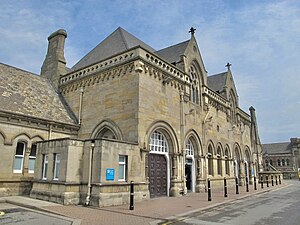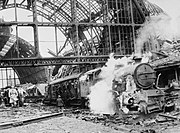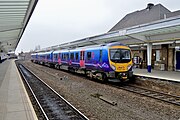Middlesbrough railway station
 Middlesbrough station in 2013 | |||||
| General information | |||||
| Location | Middlesbrough, Middlesbrough, North Yorkshire England | ||||
| Coordinates | 54°34′45″N 1°14′04″W / 54.5791464°N 1.2345092°W | ||||
| Grid reference | NZ495207 | ||||
| Owned by | Network Rail | ||||
| Managed by | TransPennine Express | ||||
| Platforms | 2 | ||||
| Tracks | 2 | ||||
| Other information | |||||
| Station code | MBR | ||||
| Classification | DfT category C1 | ||||
| History | |||||
| Original company | Stockton and Darlington Railway | ||||
| Pre-grouping | North Eastern Railway | ||||
| Post-grouping | |||||
| Key dates | |||||
| December 1830 | Opened[a] | ||||
| 1839 | Resited (second)[b] | ||||
| 26 July 1847 | Resited (third) | ||||
| 16 December 1874 | Closed (third) | ||||
| December 1877 | Resited and reopened (fourth) | ||||
| 3 August 1942 | Station extensively damaged in World War II air raid | ||||
| Passengers | |||||
| 2019/20 | |||||
| 2020/21 | |||||
| 2021/22 | |||||
| Interchange | 53,435 | ||||
| 2022/23 | |||||
| Interchange | | ||||
| 2023/24 | |||||
| Interchange | | ||||
| |||||
| |||||
Middlesbrough is a railway station on the Durham Coast, Esk Valley and Tees Valley lines. The station serves the town of Middlesbrough in North Yorkshire, England. It is owned by Network Rail and managed by TransPennine Express. Direct destinations include Darlington, Saltburn, Sunderland, Newcastle, York and Manchester Airport. There is a direct service to London Kings Cross once per weekday.
According to the Office of Rail and Road statistics, Middlesbrough railway station is the fourth busiest in the North East region, with 1,466,884 total entries and exits (2023–24 period).[1]
History
[edit]The first railway line was opened in the area in December 1830, as an extension of the Stockton and Darlington Railway to connect with the port of the (then new) town of Middlesbrough. From the opening of the line until 1837, passengers were served by a wooden shed on the route to the riverside coal staithes. The line was extended to the new exchange along Commercial Street in 1837, with a new station being constructed two years later. This new, more substantial station was opened by the S&DR in 1839.[2][3]
In June 1846, a branch line extending eastwards from the Stockton and Darlington Railway towards Redcar was opened by the Middlesbrough and Redcar Railway. Situated on the Redcar branch line on the southern edge of the new town, a new passenger station was designed by John Middleton, which opened on 26 July 1847.
As the town expanded rapidly southwards during the second half of the nineteenth century, the station was unable to cope with the increased traffic. Due to the design of the station not lending itself to expansion, it was subsequently demolished in 1874. It was replaced by the current, much larger station, which opened in December 1877. The Commercial Street station, which was increasingly isolated from the town by the opening of the Redcar branch line, became a goods station before eventually being demolished.[4][5][6]
The current station was designed by the North Eastern Railway's chief architect, William Peachey, with an ornate Gothic style frontage. Behind this, an overall roof of elliptical design once existed. It was constructed using wrought iron of lattice design, with glass covering the middle half and timber (inside) and slate (outside) covering the outer quarters. The two end screens were glazed with timber cladding around the outer edges. The roof was high in relation to its width.[7]
The elliptical roof was severely damaged in a German daylight air raid, which took place on the afternoon of 3 August 1942.[8][9] It was eventually removed in 1954 to be replaced by the current design over the concourse and platforms.[10]
A major refurbishment of the station took place during 2017 and 2018, with repairs carried out to the station's roof and stonework, as well as the upgrading of the Wood Street car park.[11] New information screens were also installed as part of the refurbishment.
As part of a major upgrade to the station, platform 2 was extended in the first half of 2021, allowing for a new direct service from Middlesbrough to London King's Cross. On 13 December 2021, a London North Eastern Railway Class 800 Azuma departed from the station at 07:08, the first direct service to the capital since 1988.[12][13]
Facilities
[edit]

The main station layout consists of an entrance hall with ticket office, large concourse/waiting area and two covered platforms that are each subdivided into two sections. Platform 1 is divided into two sub-platforms (1a and 1b), as is platform 2 (2a and 2b). Two freight lines bypass to the north of the station.
The station is staffed and has a range of facilities including a cafe/bar, newsagent's shop, cycle storage, toilets and lifts.[14] A number of information screens throughout the station provide information on train arrivals and departures.
Car parking is situated to the east of the station and can be accessed via Exchange Square and Wood Street, and by footpath directly to the station. A drop-off point is located at the front of the station, close to the main entrance.
Redevelopment
[edit]Tees Valley Metro
[edit]
Starting in 2006, Middlesbrough was mentioned within the Tees Valley Metro scheme. This was a plan to upgrade the Tees Valley Line and sections of the Esk Valley Line and Durham Coast Line to provide a faster and more frequent service across the North East of England. In the initial phases the services would have been heavy rail mostly along existing alignments with new additional infrastructure and rollingstock. The later phase would have introduced tram-trains to allow street running and further heavy rail extensions.[15][16][17][18]
As part of the scheme, Middlesbrough station would have received improved service to Darlington and Saltburn (1–2 to 4 trains per hour) as well as Nunthorpe and Hartlepool, and new rollingstock.[15] There was also the talk of new platforms at Middlesbrough,[19][20] and a new entrance to the north of the station creating access points for the Boho and Middlehaven developments.[21] The plan also suggested new street-running trams going into Middlesbrough town centre, but no concrete plans were ever submitted, and the line from Nunthorpe to Hartlepool may have been extended to include street-running to Guisborough and the Headland.[17]
However, due to a change in government in 2010 and the 2008 financial crisis, the project was ultimately shelved.[22] Several stations eventually got their suggested improvements after the scheme was cancelled and there is a possibility of improved rollingstock and services in the future which may affect Middlesbrough.[23]
Plans after Cancellation
[edit]As of 2023, the station is undergoing a major £34 million redevelopment to improve the overall layout of the station. The existing undercroft and ticket office area are being completely rebuilt, existing staircases are being repositioned and a new station entrance will be built with completion scheduled in 2024.[24]
Originally planned in the Tees Valley Metro scheme, a new platform 3 and additional track is planned to be built on the northern side of the station, increasing capacity to accommodate more trains. The £40 million project, linking in with the current redevelopment, will be funded by money secured from the scrapping of the HS2 Northern leg and is scheduled to be completed in 2025.[25][26]
Services
[edit]Northern Trains
[edit]Durham Coast Line
[edit]Northern Trains Route 2 | ||||||||||||||||||||||||||||||||||||||||||||||||||||||||||||||||||||||||||||||||||||
|---|---|---|---|---|---|---|---|---|---|---|---|---|---|---|---|---|---|---|---|---|---|---|---|---|---|---|---|---|---|---|---|---|---|---|---|---|---|---|---|---|---|---|---|---|---|---|---|---|---|---|---|---|---|---|---|---|---|---|---|---|---|---|---|---|---|---|---|---|---|---|---|---|---|---|---|---|---|---|---|---|---|---|---|---|
Durham Coast line
| ||||||||||||||||||||||||||||||||||||||||||||||||||||||||||||||||||||||||||||||||||||
| ||||||||||||||||||||||||||||||||||||||||||||||||||||||||||||||||||||||||||||||||||||
The station is served by an hourly service between Newcastle and Middlesbrough. Most trains continue to Hexham (or Carlisle on Sunday) and Nunthorpe. Two trains per day (three on Sunday) continue to Whitby.[27]
Rolling stock used: Class 156 Super Sprinter and Class 158 Express Sprinter
Esk Valley Line
[edit]Northern Trains Route 5 | |||||||||||||||||||||||||||||||||||||||||||||||||||||||||||||||||||||||||||||||||||||||||||||||||||||||||||||||||||||||||||||||||||||
|---|---|---|---|---|---|---|---|---|---|---|---|---|---|---|---|---|---|---|---|---|---|---|---|---|---|---|---|---|---|---|---|---|---|---|---|---|---|---|---|---|---|---|---|---|---|---|---|---|---|---|---|---|---|---|---|---|---|---|---|---|---|---|---|---|---|---|---|---|---|---|---|---|---|---|---|---|---|---|---|---|---|---|---|---|---|---|---|---|---|---|---|---|---|---|---|---|---|---|---|---|---|---|---|---|---|---|---|---|---|---|---|---|---|---|---|---|---|---|---|---|---|---|---|---|---|---|---|---|---|---|---|---|---|
Esk Valley line
| |||||||||||||||||||||||||||||||||||||||||||||||||||||||||||||||||||||||||||||||||||||||||||||||||||||||||||||||||||||||||||||||||||||
| |||||||||||||||||||||||||||||||||||||||||||||||||||||||||||||||||||||||||||||||||||||||||||||||||||||||||||||||||||||||||||||||||||||
The station is served by an hourly service between Middlesbrough and Nunthorpe, with two trains per day (excluding Sunday) continuing to Battersby, and six per day (four on Sunday) continuing to Whitby. Most trains continue to Newcastle, via Hartlepool.[27]
Rolling stock used: Class 156 Super Sprinter and Class 158 Express Sprinter
Tees Valley Line
[edit]Northern Trains Route 3 | ||||||||||||||||||||||||||||||||||||||||||||||||||||||||||||||||||||||||||||||||||||||||||||||||||||||||||||||||||||||||||||||
|---|---|---|---|---|---|---|---|---|---|---|---|---|---|---|---|---|---|---|---|---|---|---|---|---|---|---|---|---|---|---|---|---|---|---|---|---|---|---|---|---|---|---|---|---|---|---|---|---|---|---|---|---|---|---|---|---|---|---|---|---|---|---|---|---|---|---|---|---|---|---|---|---|---|---|---|---|---|---|---|---|---|---|---|---|---|---|---|---|---|---|---|---|---|---|---|---|---|---|---|---|---|---|---|---|---|---|---|---|---|---|---|---|---|---|---|---|---|---|---|---|---|---|---|---|---|---|
Tees Valley line
| ||||||||||||||||||||||||||||||||||||||||||||||||||||||||||||||||||||||||||||||||||||||||||||||||||||||||||||||||||||||||||||||
| ||||||||||||||||||||||||||||||||||||||||||||||||||||||||||||||||||||||||||||||||||||||||||||||||||||||||||||||||||||||||||||||
The station is served by two trains per hour between Saltburn and Darlington, via Middlesbrough, with one train per hour extending to Bishop Auckland. An hourly service operates between Saltburn and Bishop Auckland on Sunday.[27]
Rolling stock used: Class 156 Super Sprinter and Class 158 Express Sprinter
TransPennine Express
[edit]The station is served by an hourly service between Saltburn and Manchester Airport, via York. Most services run via Yarm, with the exception of one early morning arrival which travels via Darlington.[28]
Rolling stock used: Class 185 Desiro
London North Eastern Railway
[edit]LNER operates a once per weekday return service to London King's Cross, calling at Thornaby and York. More services are planned following the completion of station works.[29]
Rolling stock used: Class 800 Azuma
Gallery
[edit]-
Site of the first timber-built station, opened in 1830 by the Stockton & Darlington Railway, now an industrial estate.
-
Middlesbrough railway station after a German air raid on 3 August 1942.
-
Middlesbrough railway station in July 1977, looking west towards Thornaby.
-
Class 185 Desiro at platform 2, April 2013.
Notes
[edit]References
[edit]Citations
[edit]- ^ "Estimates of station usage 2023/24". Office of Rail and Road. Retrieved 22 November 2024.
- ^ "Railway Architecture of North East England : Middlesbrough". W. Fawcett, 2011. Retrieved 28 December 2020.
- ^ "December 1861 map of Middlesbrough North Riding: A Vision of Britain Through Time". University of Portsmouth and others. Retrieved 11 December 2015.
- ^ Body 1988, pp. 118–9
- ^ "Railway Architecture of North East England : Middlesbrough Station". W. Fawcett, 2011. Retrieved 31 March 2014.
- ^ "Yorkshire 6 (includes: Billingham; Middlesbrough.) Surveyed: 1853 Published: 1857". Old Maps Online: National Library of Scotland. Retrieved 4 January 2021.
- ^ Delplanque, Paul. "Middlesbrough Railway Station...Then and now". GazetteLive. Retrieved 21 January 2011.
- ^ Hitches, M – Steam Around Middlesbrough (Amberley Publishing, 2014) p. 69
- ^ "On this day in Yorkshire 1942: Train Missed Middlesbrough Bombing by Minutes". The Yorkshire Post. 3 November 2016. Retrieved 17 July 2017.
- ^ "Railway Architecture of North East England : Middlesbrough Station". W. Fawcett, 2011. Retrieved 26 November 2015.
- ^ Brown, Mike (21 December 2016). "Middlesbrough Railway Station: £2.7m refurbishment will start in the new year". GazetteLive. Retrieved 30 December 2016.
- ^ "LNER launches new Middlesbrough to London trains". BBC News. 13 December 2021. Retrieved 13 December 2021.
- ^ "Fireworks and music as new LNER Azuma direct train leaves Middlesbrough for London Kings Cross". Teesside Live. 13 December 2021. Retrieved 16 December 2021.
- ^ "Station facilities for Middlesbrough (MBR)". National Rail. Retrieved 31 March 2014.
- ^ a b Tees valley Unlimited (18 May 2010). "Tees Valley Metro: Phase 1 - Project Summary" (PDF). Stockton-on-Tess Borough Council.
- ^ Tees Valley Unlimited (April 2011). "Connecting the Tees Valley - Statement of Transport Ambition" (PDF). Retrieved 11 November 2024.
- ^ a b LOWES, RON; PARKER, IAN (18 September 2007). "Executive Report - Tees Valley Metro" (PDF). Retrieved 11 November 2024.
- ^ "Metro system hope for Tees Valley". 9 November 2006. Retrieved 11 November 2024.
- ^ Tees valley Unlimited (18 May 2010). "Tees Valley Metro: Phase 1 - Project Summary" (PDF). Stockton-on-Tess Borough Council.
- ^ LOWES, RON; PARKER, IAN (18 September 2007). "Executive Report - Tees Valley Metro" (PDF).
- ^ Tees Valley Unlimited (April 2011). "Connecting the Tees Valley - Statement of Transport Ambition" (PDF). Retrieved 5 November 2024.
- ^ "When the Tees Valley was set to get its own £220m metro system and what went wrong". The Northern Echo. 4 February 2023. Retrieved 11 November 2024.
- ^ "Tees Valley authority unanimously backs £1bn transport plan". BBC News. 27 January 2024. Retrieved 11 November 2024.
- ^ Banks, Georgia (13 February 2023). "British steel to be used in £34m Middlesbrough station revamp". Teesside Live. Retrieved 25 March 2023.
- ^ "Middlesbrough Rail Station". ©Tees Valley Combined Authority. Retrieved 29 January 2024.
- ^ "Mayor Unveils His £1Billion Transport Plan For Region". ©Tees Valley Combined Authority. 15 January 2024. Retrieved 29 January 2024.
- ^ a b c "Timetables and engineering information for travel with Northern". Northern Railway. 2 June 2024. Retrieved 4 November 2024.
- ^ "Timetables". TransPennine Express. 2 June 2024. Retrieved 4 November 2024.
- ^ "Our Timetables". London North Eastern Railway. Retrieved 13 December 2021.
Bibliography
[edit]- Body, G (1988). PSL Field Guides – Railways of the Eastern Region Volume 2. Wellingborough: Patrick Stephens Ltd. ISBN 1-85260-072-1.
External links
[edit]- Train times and station information for Middlesbrough railway station from National Rail
- Railway stations in Middlesbrough
- Grade II listed railway stations
- Former North Eastern Railway (UK) stations
- Railway stations in Great Britain opened in 1877
- Railway stations served by TransPennine Express
- Railway stations served by Northern
- John Middleton railway stations
- William Peachey railway stations
- DfT Category C1 stations
- Railway stations served by London North Eastern Railway







